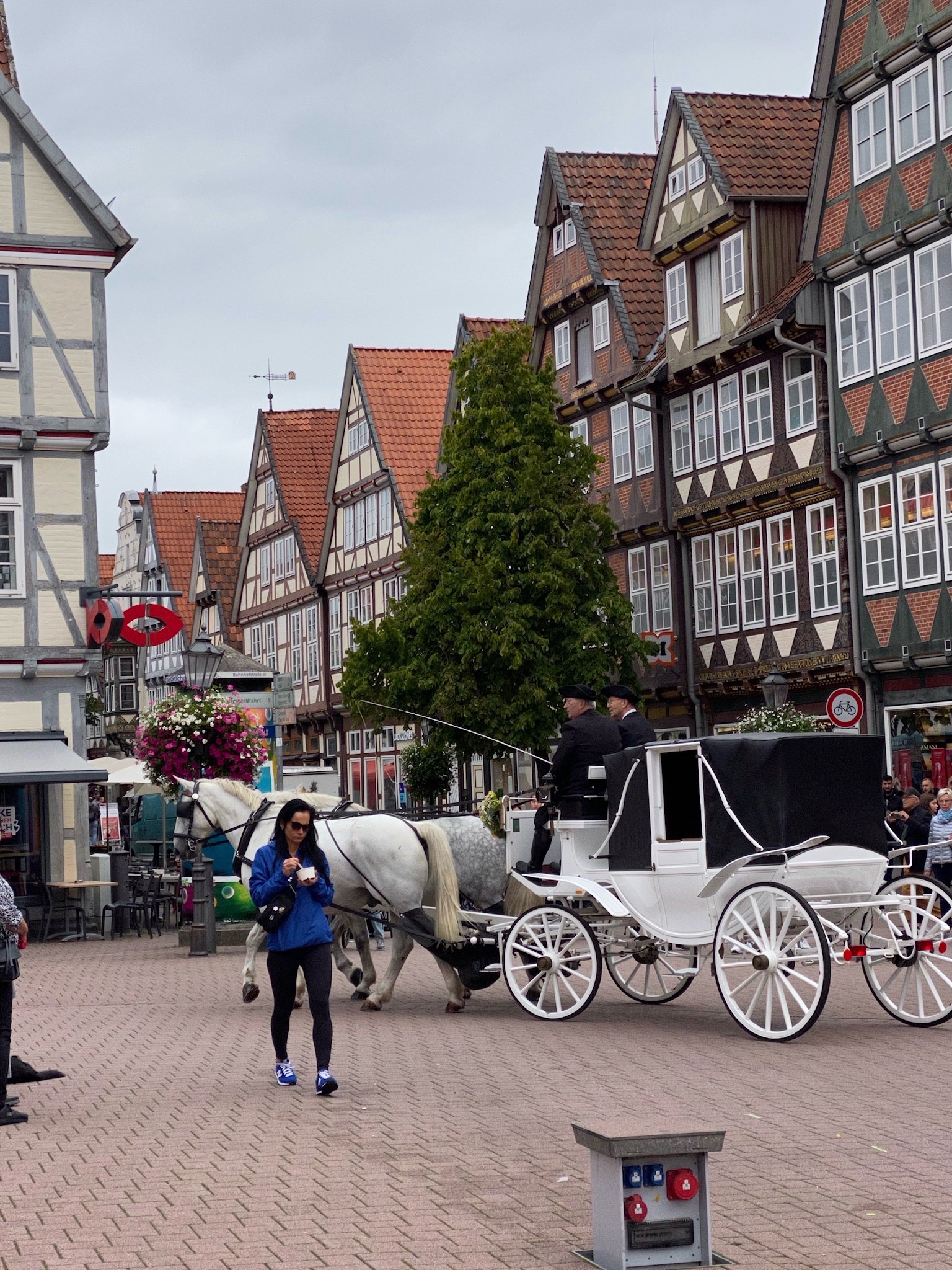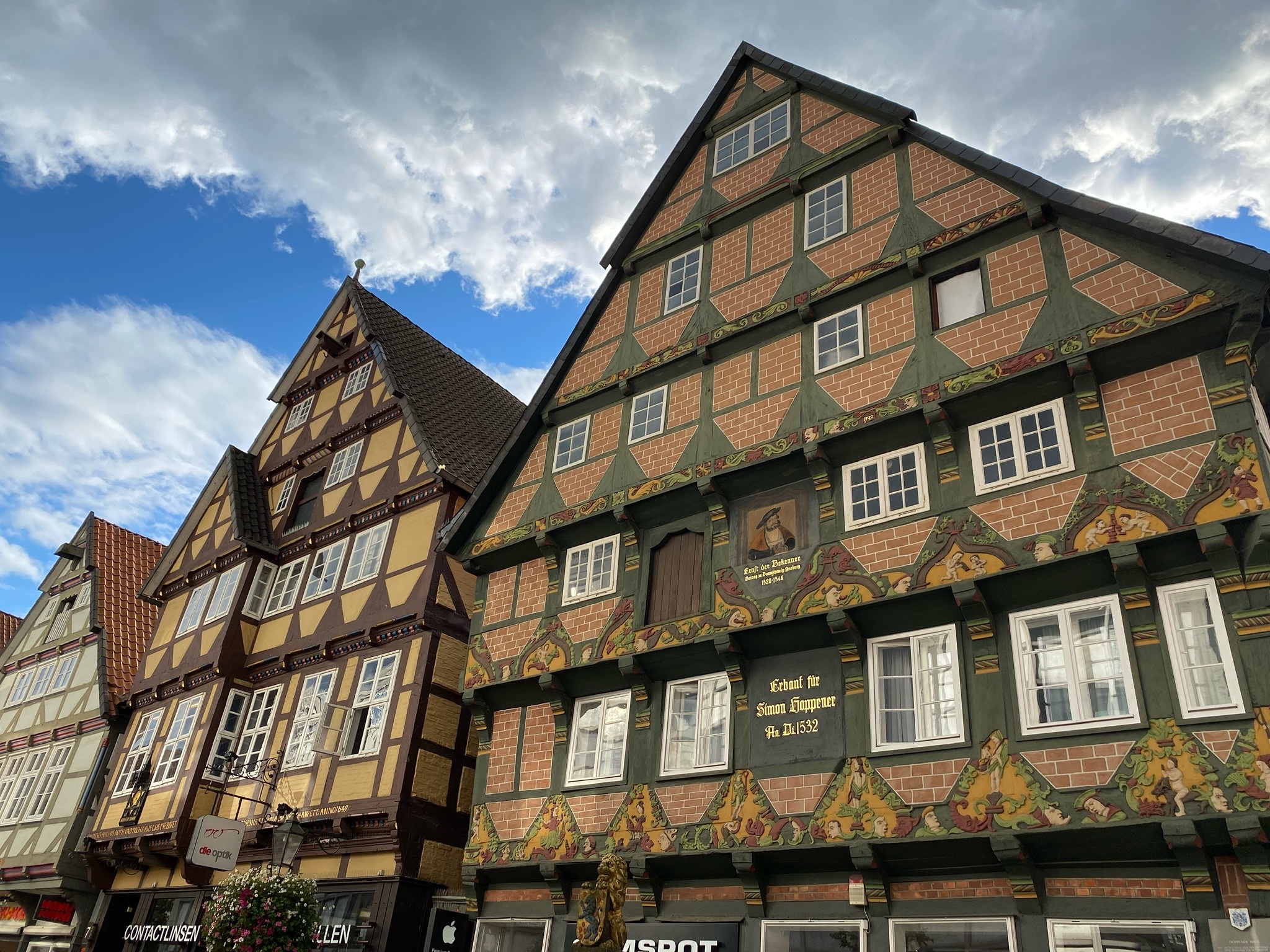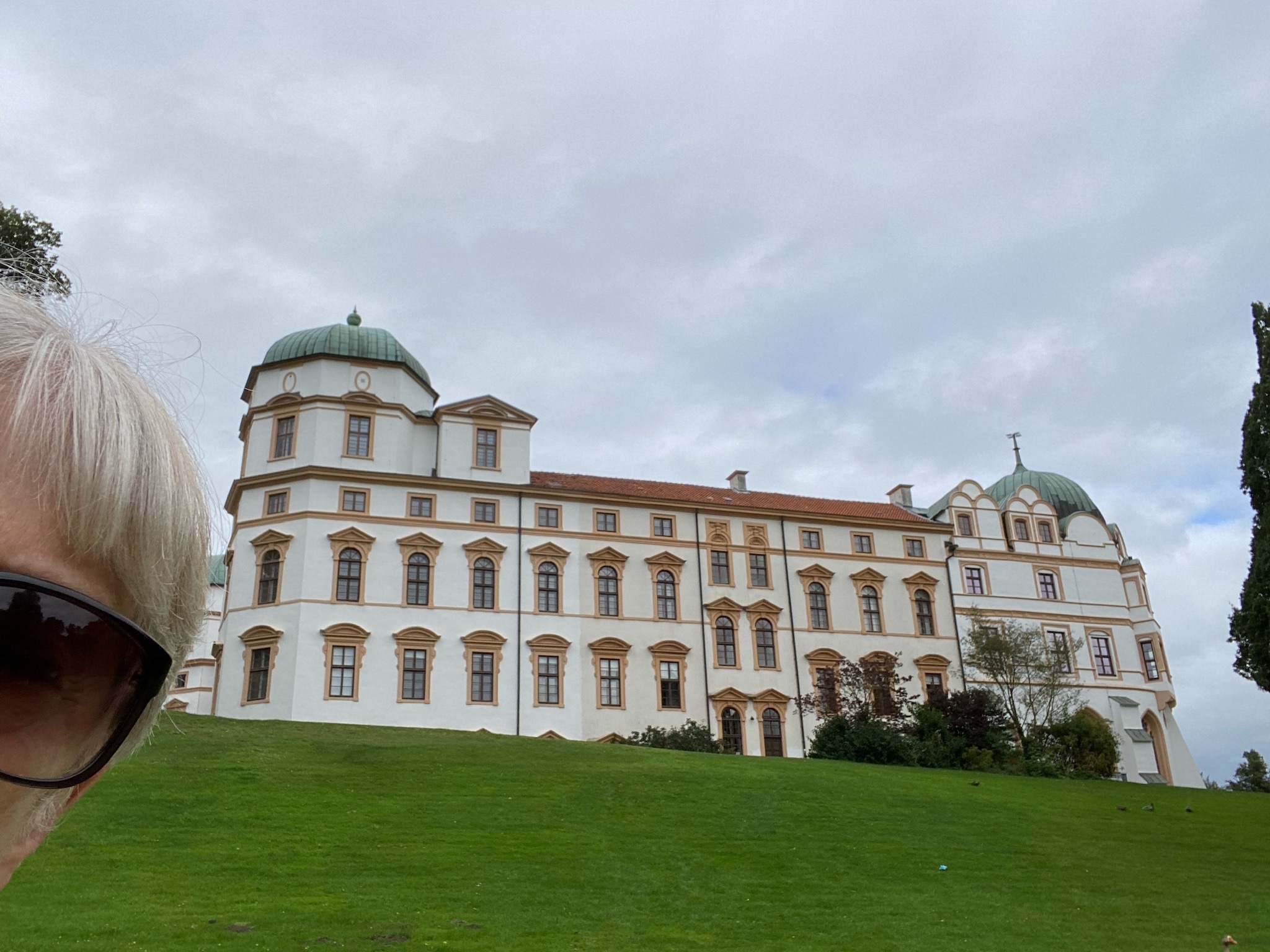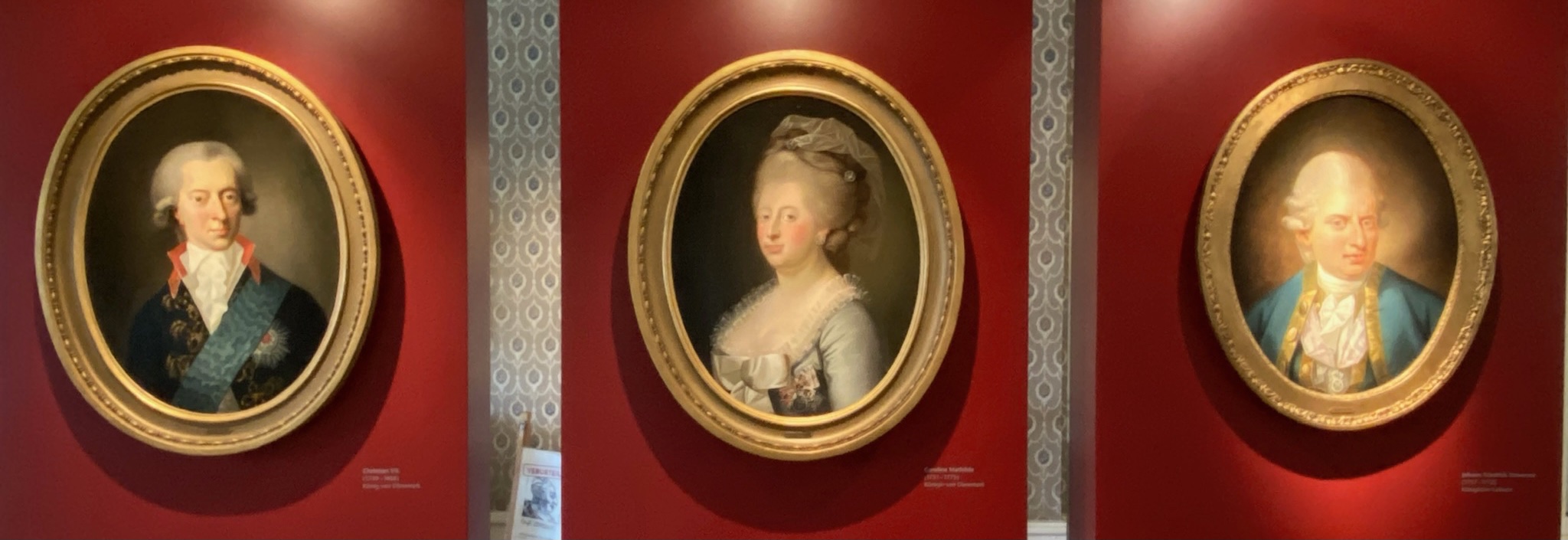19 September 2021
Walking Celle is like strolling through a Brothers Grimm folktale.

Walk Celle’s streets, ogle its magnificent architecture, enjoy the statues and fountains, and stand in the Markt Plaza when the Glockenspiel rings out. Overall, this is a charming city that should not be overlooked in one’s travels of Lower Saxony.
Celle is situated on the banks of the Aller River and is one of many wonderful cities along the Timber-Frame Road. Attractions include a castle, museums, and lots of street art in the form of a series of figures engaged in life about Celle. But for me, the main attractions are the timber-framed houses, some 400 of them, that line the streets of the historic Altstadt. It’s proximity to the beautiful, and fragrant, Lüneburg Heath is another reason to spend a couple days here.
The German Timber-Frame Road is a route beginning from cities in the north along the Elbe thru the Black Forest and leading to Lake Constance in the south. There are numerous cities along the zigzagging route that are examples of the traditional timber-framed houses of Germany. The entire route is over 1800 miles and passes through six regional sections beginning with the city of Stade in the north to Meersburg in the south, with more than 80 along the route. (An additional area is grouped around Dresden in the east.)
And therein lies the recognition of the Brothers Grimm. The brothers were born in the timber-framed town of Hanau and spent much of their childhood in the similarly built nearby town of Steinau, both about 180 miles south of Celle. Both towns are recognized as stops along Germany’s Timber-Frame Road. One can easily imagine where the brother’s vivid location descriptions originated.
Celle was first mentioned in a document around A.D. 985. It’s first fortified castle-like structure was about the same time. Walking the cobblestone streets, one can engage in a game of finding the oldest home. Most accommodate with Old German lettering, dates and legends gold embossed around their frames. I spot structures built in 1645, 1634, 1540, 1534, 1532.

The Hoppener Haus, built 1532 for Simon Hoppener, is a half timbered house of six staggered storeys and magnificent ornate façade. The second and third storeys are decorated with rich and colorful ornamentation depicting mythical creatures, snakes, nasty looking faces, and even some planets and gods. Also strangely prominent is the portrait of Duke Ernest the Confessor 1520-1546, though he was a much later addition. Directly in front of the house a historical fountain displays a heraldic lion.
But the Hoppener Haus is just one of many interesting examples of this style of timber-framed and staggered-storey homes built in Celle. There are many others, like the dark green five-storey built in 1534, or all of the homes and shops around Markt Plaza in the center of Celle. And while in the Markt, don’t miss the Glockenspiel performance which we were able to enjoy at several times throughout the day.
On the very opposite end of any fairytale spectrum – One site to note in the history of Celle: in the Trift there is Memorial Tree planted in memory of the Celle Massacre. On 8 April 1945, Celle suffered its only major bombing raid during World War 2 but it created a spectacularly unfortunate turn of events. A train pausing next to a storage of ammunition and carrying about 4,000 slave workers and civilian prisoners to Belsen Concentration Camp was hit, causing hundreds of casualties. The few who escaped fled to the forests pursued by SS guards and Celle citizens who took part in the infamous ‘Celle hare hunt,’ killing several hundred. Few survived to tell the tale. Celle surrendered to British troops on 12 April 1945.
CELLE CASTLE

Celle Castle was just one of the palaces of the Duchy of Braunschweig-Lüneburg (Reigning House of Welf) and the largest palace in the area. The Welfs were at the peak of their power in the 12th century and again during the 18th and 19th centuries as the House of Hannover became connected with kings of Great Britain in the person of King George I. The family is still important; the last member of the House of Welf, former Queen Friederike of Greece died 1981, and her nephew, Ernst who married princess Caroline of Monaco, is currently the head of the Welf family. And of course, there have been five more George’s who reigned in Great Britain, up to 1952, and the VI’s daughter is the current Queen Elizabeth.
The castle was built around 980 as a fortified wall tower with the character of a water castle meant to guard a ford over the River Aller. Otto the Strict continued developing the building in 1292.
As a consequence of the War of the Lüneburg Succession, the Dukes moved their Residenz from Lüneburg to Celle and began the upgrades which resulted in the current castle (first documented in 1315), adding ramparts, moats, rooms and a chapel in 1485. Successor dukes enlarged, decorated in the favored style of the time, built towers and added ‘elbow room.’ It was Duke George William who adopted the Venetian decor which highlights the castle architecture today. He also contributed to the beginning chapters of interesting castle intrigue:

George William was to inherit the principality and marry Sophia von der Pfalz. He decided to “pass” on Sophia and have his brother, Ernst August, marry her. George married “beneath his station” to Éléonore d’Olbreuse, a French Huguenot noblewoman. They had daughter Sophia Dorothea.
Meanwhile, brother Ernst and Sophia had son George and daughter Sophia Charlotte. The brothers thought it a good idea to bind first cousins, Sophia Dorothea and George, in matrimony. Affairs were common among the royals but what was always permissible for the gander was not allowed for the goose. Their imperfect union produced two children, another George and Sophia Dorothea #2 (showing little originality in naming children). Said Union also produced a nasty divorce and a punishing 30 year exile for wife Sophia Dorothea who was never allowed to see her children again. Husband George waltzed his way into becoming King George I of Great Britain; his sister Sophia Charlotte married King Friedrich I of Prussia and they had Friedrich Wilhelm I.
So Sophia Dorothea, who never got to go to her children’s special events, and ex-husband George who got to be King of Great Britain, had above said children. Son George II was assured the throne of Great Britain. As if they hadn’t learned by now, the king still thought it a great idea to marry off his daughter Sophia Dorothea #2 to a 1st cousin, the son of Sophia Charlotte, Friederich Wilhelm I – but then this couple did produce the future Friedrich the Great.
Got all that? Because there may be a test later. The intrigue thickens:
King George II, who is dividing his time between Hannover and running the entire show in Great Britain, produces a daughter who brings some new blood into the family by marrying the King of Denmark. They have a son, the future King Christian VII. Meanwhile, a son of George II doesn’t seem to produce much except the future King George III and a beautiful princess, Caroline Mathilde.

Finding no other suitable marriages in all of Europe for his daughter, Caroline Mathilde is married to her 1st cousin Christian, he who would become the mentally shaky King of Denmark. She was 15. It was not a happy union. Caroline Mathilde would break the gander/goose rule in spectacular fashion with the King’s physician Johann Friedrich Struensee, a man who became an early influencer long before internet. The physician might also have produced a daughter with the Queen. Neither achievements were appreciated. Both were arrested in 1771. Struensee was executed, condemned first to lose his right hand and then beheaded with his body ultimately drawn and quartered. Yikes! Caroline Mathilde was exiled to the castle here in Celle. She died here of scarlet fever in 1775 at the age of 22.
This would be the same castle my grandmother gazed upon a century ago.
External features of Celle Castle are the unusual domed towers and gables. Because the castle was never used for any military purposes, trees, shrubs and lawn were planted over the previous defensive battlements in 1826. Further landscaping was added thru the century and today the gardens consist of 17 acres with the castle itself surrounded by moats.
Celle’s Bomann Museum, just across the moat, is dedicated to the history of the Kingdom of Hannover, and has an excellent selection of items dating from prehistory to present. Also attached are complete rooms and living quarters for the early commoners of the community. Explanations all in German but well worth a visit.

Like most castles that were built and expanded, remodeled and redecorated under different owners, Celle Castle has a mix of rooms which reflect different periods ranging from Baroque, to Gothic, to Renaissance decor. The chapel was converted after the Reformation and its renaissance architecture is mostly unchanged. Most of the state rooms are a Baroque style while there is a Gothic style hall used for exhibiting displays on regional history of the Kingdom of Hannover. The two most beautiful rooms, the chapel and theater, require tours given only in German. The castle is relatively small and unassuming but after the death of George William in 1705 the government moved elsewhere and Celle gained a high court, a jail and a lunatic asylum. The castle was left to the elements until Mathilde’s brief incarceration.
Being royal was a tough job!
0 Comments